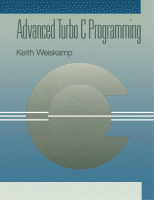Browse content
Table of contents
Actions for selected chapters
- Full text access
- Book chapterNo access
INDEX
Pages 553-558
About the book
Description
Advanced Turbo C Programming provides the necessary programming tools for programmers who are interested in learning new skills in developing some useful tools and PC applications using the Turbo C Version 1.5 programming language and environment. This book covers both the advanced programming features of the IBM PC and Turbo C. It is organized into five sections. In Section 1 the proposed ANSI standard features, tips and techniques about C programming style, working with the C preprocessor, and tips for using pointers and managing memory allocation tasks are introduced. Section 2 discusses techniques for constructing useful and reliable data structures from linked lists to binary trees. The third section provides the complete Turbo C I/O system and takes an in-depth look at the many tools that Turbo C provides for accessing files and other I/O devices. Section 4 explains the techniques for interacting with DOS and the special features of Turbo C such as the Borland Graphic Interface (BGI). The final section, Section 5 presents the tools and techniques for developing Turbo C-like user interfaces, such as pop-up windows, pop-up menus, and pulldown menus. Computer programmers will find the text invaluable.
Advanced Turbo C Programming provides the necessary programming tools for programmers who are interested in learning new skills in developing some useful tools and PC applications using the Turbo C Version 1.5 programming language and environment. This book covers both the advanced programming features of the IBM PC and Turbo C. It is organized into five sections. In Section 1 the proposed ANSI standard features, tips and techniques about C programming style, working with the C preprocessor, and tips for using pointers and managing memory allocation tasks are introduced. Section 2 discusses techniques for constructing useful and reliable data structures from linked lists to binary trees. The third section provides the complete Turbo C I/O system and takes an in-depth look at the many tools that Turbo C provides for accessing files and other I/O devices. Section 4 explains the techniques for interacting with DOS and the special features of Turbo C such as the Borland Graphic Interface (BGI). The final section, Section 5 presents the tools and techniques for developing Turbo C-like user interfaces, such as pop-up windows, pop-up menus, and pulldown menus. Computer programmers will find the text invaluable.
Details
ISBN
978-0-12-742689-1
Language
English
Published
1988
Copyright
Copyright © 1988 Elsevier Inc. All rights reserved.
Imprint
Academic Press
